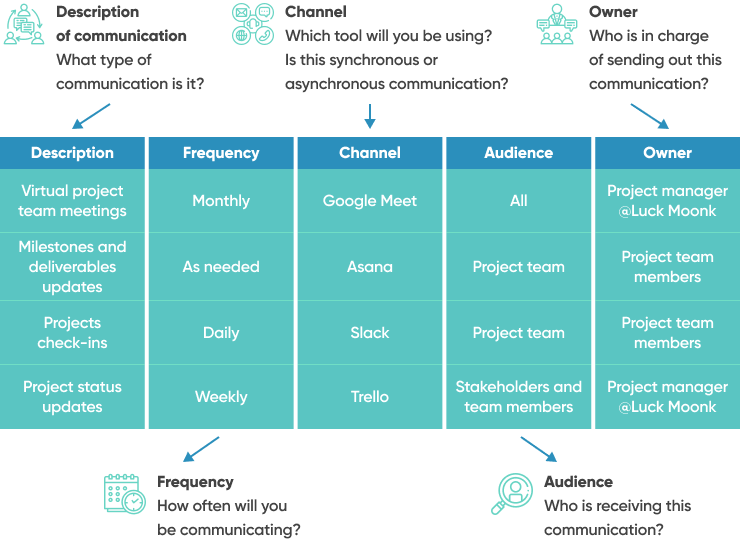Effective communication is the foundation of a successful project. Sadly, it doesn't always work as it is supposed to - and in fact, many projects face this problem. If you haven't used a communication plan in past projects, it's worth trying and discovering what benefits it may bring to you and your team.
One thing to remember is that even in professional relations, people on both sides are... well, people. Having that in mind is especially helpful when deadlines are exceeded or problems arise during the work. Be transparent and honestly explain what happened. Such action will always be received better than operating on outdated and incomplete pictures of the project.
Lack of communication can cause many problems and can negatively impact the relations with clients, so it is always worth increasing the project communication management. In this article, we describe how to establish communication in a team with a communication plan and how to communicate with project stakeholders.
What is communication plan in project management?
A communication plan outlines how you'll communicate important project updates to key stakeholders. Your communication strategy will help your team decide who should receive which alerts and when. In your communication strategy, you'll specify which channels stakeholders should use, when, how often, and who is responsible for each.
Communication strategies can help your team understand which tools to use when and who to contact. If you don't have a communication strategy, one team member may try to ask questions about work in a tool that another team member rarely checks. Each team member would become confused and detached from the important task at hand. They may end up reaching out to an executive stakeholder with questions that they cannot answer. Was a simple misunderstanding turned into three unhappy co-workers—and the job is not done.
The benefits of a communication plan
Benefits of a well-implemented Communication Plan A planned framework for internal communication allows employees to feel at ease and contribute to the company's lively culture. This vibrant culture contributes to the many benefits of effective communication. The plan can help many project managers define team communication.
It is commonly said that less is more. The knowledge team loses hours simply trying to find out where they should communicate rather than focusing on high-impact tasks or even efficiently collaborating with the team.
This may be avoided with a well-thought-out communication plan. If your project team understands that you exclusively talk about work in a work management platform, they may hunt for crucial information there rather than sifting through folders of papers, Slack conversations, and several email threads. Similarly, if you know a team member is only slightly involved in the project - and is only mentioned in high-level status reports - you won't bother him or her with questions about when the next project job is due.

The project management communication plan clearly defines the way of communication between project members and the project manager. Because collaboration in the team is not a natural process which needs to be worked out and developed in order for the team to work well. Clarifying your team's communication standards is one component of building efficient team collaboration especially if you work on a remote team.
The communication plan specifies how and where the team should communicate and includes communication frequency. By giving these rules, you remove one of the main obstacles to team communication and cooperation. Team members can give the right message at the right moment when they know where to communicate and where not to communicate.
All project team is on the same pageTeam members spend a lot of time looking for papers, pursuing approvals, switching applications, checking on work, and other tasks that take time away from productive work. Part of the problem is not knowing where to communicate.
If team members don't know where information is provided, like your software project plan or application modernization roadmap, they'll have to go through different tools or ask several coworkers to discover it. As a result, teams who are unsure where to communicate about work have a tougher difficulty getting the job done.
In truth, workers frequently undertake work that has already been finished. By providing your communication strategy, you save your team time by letting them know where work is located.
3 fundamentals of communication with a client
A solid relationship with the customer is the way to success. In order to build a good relationship with the client based on trust, communication, and respect, it is necessary to consider the following principles. Successful projects run on effective communication.
You have to be always available to the client. It is important to timely giveback calls, answer emails, respond to messengers, etc. Involve clients at each stage of the work, they should see the whole process. Organize shared online access to the project's schedule, ask clients to give comments and listen to their suggestions, and give them tasks (or let them give tasks to you). When the customer feels like they are part of the project, the feeling of will be replaced by excitement and appreciation.
Gather informationPut yourself in customers’ shoes and discover the motives of their requests and goals. Motives can be obvious or hidden. If you feel that you don’t have enough information to get a full scope of the task — you need to ask for it.
You are about to invest your time in solving these problems. You need to understand all the aspects before setting priorities. Everything has to be completely transparent. If you have received a task or a user story and spot contentious issues or gaps, you have to make sure to fill them in. Try to get the full story to be on the same page with your client. You and your client might look differently at tasks and their solutions. The client may talk about one thing, think about another one, and expect something completely different.
Honest, respectful, moderationMost businesses pick their target client carefully. So, if you've collaborated with someone, remember:
- Honesty: quickly acknowledge any concerns or shortcomings so the client may make arrangements. Errors happen to everyone, but suppressing them is a sin.
- Respect: your client has peculiarities. But they picked and will pay for your services. For this alone, they deserve recognition.
- Moderation: keep emotions in check when communicating with clients. They may be rude or grumpy, but acting the same way will do you no good. If you're enraged, vent it inside the team. Apologize if you overlooked something during a customer meeting. That doesn't mean we'll tolerate their actions. You can end a contract if a consumer abruptly stops communicating and becomes disrespectful. Everything else is doable and negotiable.
Project communication plan in 4 steps
A good project communication plan is a tool that can define and improve communication on the project, but most importantly it is easy to create and implement.
Identify methods of communication
Determining communication methods involves choosing where and in what situation team members will communicate with each other. At this stage, a specific tool is chosen. It is also important to define when to communicate so that each team member can adjust his/her working hours accordingly. Live vs. asynchronously are among the topics covered. Communication that takes place in real-time is referred to as live, synchronous communication. Asynchronous communication, on the other hand, occurs when you send a message without expecting a response right away.
For example:
- Email - more formal messages, external stakeholders
- Slack - quick questions and daily updates
- Google Meet - brainstorms, team meeting, screen shear to solve the problem

Up-to-date with a communication plan
You must now determine how frequently you will communicate after determining where you will communicate. Your communication cadence is a strategy for keeping various stakeholders informed about various project details.
Find out your options:
- Daily
- Weekly
- Monthly
- Asynchronous
Include a plan for stakeholder management
Stakeholder involvement and contribution often equal the project's success. Take some time when drafting your communication plan to specify when and what you'll communicate with each project stakeholder. Some people, such as your key members of the project team, will be discussing this project on a regular basis—possibly even daily. Other project stakeholders may only need to be informed during project status updates or at the end of the project.
You can ensure that stakeholders are contacted at the right time and about the right things by outlining how you'll manage communication with them. The information they receive should respond to their questions in great detail, with a focus on business outcomes and overall, high-level impact.
Outline your communication plan and stay up-to-date
It's time to discuss your communication plan with your project team once you've finished it. Make sure that your communication plan is available in your single source of truth for all project information. You can use technologies to keep track of all project communication and work, allowing you to discuss work while you're on the job.
If there are any changes that affect your project communication plan, make sure to update it and convey them. Team members will always have the most up-to-date information this way.
Communication Case Study

Informing clients that you have received a task
Case A: The client assigns a task A developer can look at it.
Solution: Either tell the client you'll look into it right away and get back to him with more information, or ask questions to better understand what needs to be done.
Case B: The client assigns a task No developer can't look at it right away.
Solution: Thank them for the information and tell them you will start working on it as soon as possible. You've let them know you're not available right now, but will be as soon as you are. Provide NLT whenever possible (not later than). "I can't look at it right now, but I will by Thursday"...
Not:
- Ignore the task for a day or two until you can resolve it.
- Explain why you can't do this right away. You will only complicate things.
Keeping the client informed about the task progress
In most cases, a developer will inform the client that he has begun work and will not update until it is complete. It is the right approach for a task that will take a day or two to complete, as we do not want to burden the client with too many updates. However, more time-consuming tasks that require at least 7-10 days to complete should be updated periodically.
Notifications should be:
- Too big or too short
- Weakly (i.e. if you are working on it for 7 days, 3 updates are enough)
- Write only relevant information such as what you have done so far and what the next step is (and NEW obstacles/risks/challenges + their potential impact). Usually, the riskiest parts of a task come first. It is also good to inquire.
Start now and update the client at the end of the day. At least you tried.
Solution: Be honest about what's going on. That is why you are starting now. You'll apologize and prioritize. Maybe the client isn't happy with these explanations now, but don't worry.
Do not:
- Hide the truth to the client about something you haven't even started. Remember, lies always come out.
Short, clear, and to the point messages
Why not ask the client for a quick call to discuss it if you don't like writing long posts? You'll know right away what he thinks of the proposed solution, and it'll save you time over writing a lengthy post. If at all possible, try to keep things simple. Voice communication is more effective at forming a bond with clients.
Inform the client of your vacations and duties on time
Inform your client about your vacation plans so he can plan tasks for you. Also, avoid taking on complex tasks knowing that you will be gone and unable to monitor their progress. If you're going on vacation, designate a backup developer.
Sickness or other unexpected events may require you to notify your teammates or team leader that you will be unavailable for a period of time. Clients will respect you if you use these methods.
But what if the client is slowing down the project and the release date is now 2 weeks away?
(You planned a vacation in a week because the project was due.)
This requires an individual approach and a deeper analysis of the situation. If you're unsure how to react, ask yourself this question:
- How important is this project to your firm?
- Are we really going to launch in 2 weeks or 4-6 weeks?
- Can you postpone your vacation for a few weeks?
- Can someone cover for you while you're away?
If you are willing to move your vacation to accommodate the project, inform the client of your decision and provide a clear timeline for your availability. So you won't feel guilty if you miss another deadline.
Project communication plan template
On the internet, you can find many project communication plan examples, but it is best to create your own version and keep it simple and clear.

Conclusion
It’s important to keep in mind that you and your client are one team from the moment you sign the contract.
Good communication between the team and the client is the basis for achieving common goals. As a result, the entire technical team should make establishing a strong bond with a customer a priority.
The foundation of a long-term partnership is being respectful, considerate, always open-minded, and available for discussion.
Furthermore, despite the distance that may separate you, it is critical to ensure that your client feels involved and present in the project. A strong and trusting relationship with the client is essential for a positive project experience.

![Communication Plan in Project Management [Practical Template]](/.netlify/images?url=_astro%2Fwhat-is-communication-plan-in-project-management.Cy6dcKcr.png)





